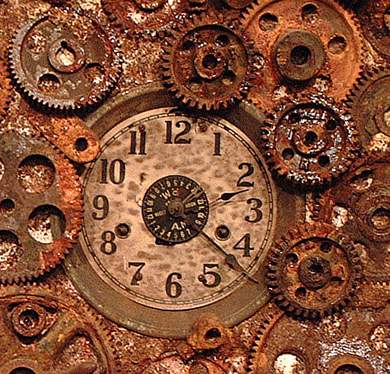Concept
As technology spreads into the future, the obsolete are left behind. New things are created, while past creations decay. Nature begins to take apart what man once struggled to assemble. There is a threshold that is hard to pinpoint, when a manmade object becomes nature again. The difference between the two becomes blurred, and the beauty of this transition becomes visible: Concrete cracks with plant life. Iron and steel bleed rusty stains. Years of paint stratify walls. Wood warps and buckles to the elements. Trees grow upon the tar roofs of skyscrapers. Detroit is this transition.
Through the RELICS installation, man once again alters nature by extracting these objects, interrupting their return to the earth, and using them to create a contemporary museum of natural history. Patrons of this reliquary room sensually engage the history of Detroit, encompassed by energy and information. The viewer is overloaded by input, not unlike the artist’s own experiences while exploring forgotten sites. The senses are flooded, and one becomes fully aware of his/her surroundings — in the present moment — triggered by objects of the past.
Like everything and everyone, Detroit is moving and changing through time. Transiting cycles of birth, death, and rebirth; the City is our creation, and therefore, reflects our behavior. In the 300-some years since being named “the strait,” Detroit has gone from pure marshes and forests teeming with wildlife, to expanding farmland and industry that expended and veiled the fertile ground, to a state of post industrial wasteland with a waning population. Inhabitants have steadily fanned out of the core in a concentric pattern, leaving the civic center for nature to reclaim with infinite persistence. Now, a state of renaissance and rebirth is blossoming in the city’s core, and the natural cycle continues. The RELICS installation attempts to capture this state of transition and present the viewer with questions regarding art, history, and time — especially the dramatic changes over the last 100 years. How long, in this ever-changing landscape of our present world, does it take for something to be forgotten?
RELICS aims for a communication with viewers regarding what we, as civilized creatures, are creating, destroying, and leaving behind. It is meant to spark reveries and inspire conversation with strangers, and simply, to overwhelm viewers with the sheer mass of information, memory, and energy generated by thousands of relics of the future.
Logistics
At last count, over 400 wooden “boxes” make up the reliquary walls that create this installation. Each box measures 18” x 18” on the face, with a 12” depth. The boxes are made of medium-density fiberboard, 6 tons of it, and assembled in a chasing pattern with wooden screws and glue. The content of each box is secured by a variety of adhesives and hardware, whether recessing within the cube or protruding beyond the face. Each box rests upon those below, and is secured to the others and a supporting wall (unless free standing). Box construction places all weight upon the vertical boards, with added strength from wall to wall, or box to box pressure. Weight of individual units varies from about 10 to 100 pounds, with the heaviest being in the minority. The entire installation is modular and adaptable to any space, utilizing each site individually, but a large area with high ceilings is ideal. The boxes are open to the elements and human contact — naturally, they may change through travel and exposure. Some have been sold, others have been destroyed and/or recycled, and new boxes continue to be created. The installation is reconfigured and updated according to location and theme; hence, a detailed architectural plan of the potential exhibition area is necessary to determine the size and dimensions of this reincarnation.
[ Click here to enter the visual essay ]
- Follow us on Twitter: @inthefray
- Comment on stories or like us on Facebook
- Subscribe to our free email newsletter
- Send us your writing, photography, or artwork
- Republish our Creative Commons-licensed content


 Detroit’s transition from past to present.
Detroit’s transition from past to present. 